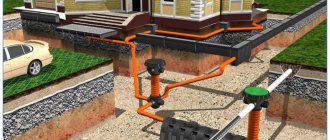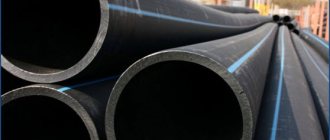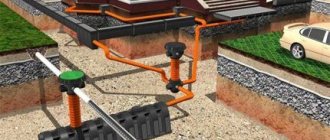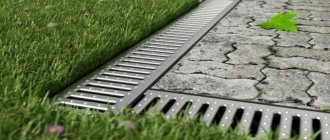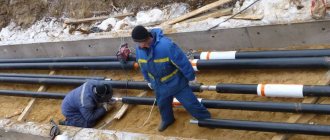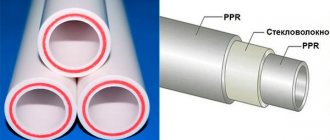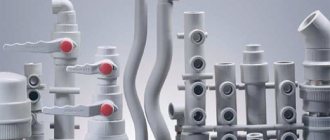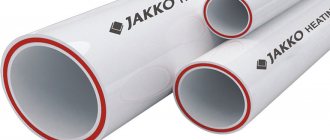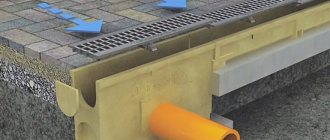Preliminary calculations of the drainage system
Complex calculations and soil studies are carried out when planning serious and important buildings, engineering structures, roads, bridges and tunnels, and residential areas.
At the level of the owner of a summer cottage, a small country house, a garage, or outbuildings, complex calculations are not in demand, since they are quite expensive and incomprehensible in the practical everyday use of a land plot.
Owners of summer cottages do not need to understand complex calculations that are already included in the cost of turnkey work Source studway.com.ua
The design of a garden, vegetable garden and even a residential building is carried out on the basis of general data on the approximate level of groundwater, the proximity of a reservoir, information on the depth of a well or borehole, spring floods and other information.
At the same time, almost all owners of private houses, summer cottages and land plots were faced with the problem of drainage, water drainage and other issues of land reclamation and water use, which required the installation of a drainage system for drainage of groundwater.
Despite the apparent simplicity of the work, it is difficult to figure out on your own which drainage system device for draining groundwater will be optimal in a particular case, and what materials: filters, pipes to drain water from the site. Errors at this stage lead to the need to completely redo the drainage, which entails not only additional costs, but also the need to re-change the design and arrangement of the site.
It is much easier and more economical to turn to professionals who can carry out the necessary calculations and make a turnkey drainage system.
The main signs by which you can determine the need for drainage work
Obvious signs of the need for drainage Source otoplenie-help.ru
You cannot do without drainage on the site if:
- Water-loving plants predominate in the garden and vegetable garden, sow thistle has appeared, the ground is soft and wet all year round, trees grow poorly, some die, moss has appeared on the soil and trees in the garden. All these are signs of excessive soil moisture - drainage is required.
- High humidity in the basement or basement, condensation on the basement walls, the appearance of microcracks in the basement of the building, distortions in door and window openings, a feeling of dampness and mold in the room. The building needs to be saved - without drainage work, the foundation and the house will be destroyed.
- Even after light precipitation, puddles remain for a long time, blind areas crack and move away from the base, sidewalks and road surfaces sag - at a minimum, drainage of surface water is necessary.
Significant advantages of arranging a drainage system Source vse-o-kanalizacii.ru
Which ones are better?
For storm water
Smooth plastic pipes with a minimum stiffness coefficient (for example SN2) are ideal for collecting surface water.
You should not overpay for products with high strength characteristics. Corrugation is not needed here either.
For drainage of groundwater
To drain groundwater, the most successful option would be to choose a corrugated multilayer pipe with perforation and protection in the form of a coconut filter. Yes, this product is not the cheapest on the market. But such a pipe will 100% protect your foundation from destruction, and, accordingly, from gigantic financial costs.
The pipe must be selected based on the SN parameter.
Types of drainage
Drainage systems for draining groundwater can be divided into two main types: open and closed:
- Open surface drainage consists of ordinary ditches with a slope directed towards natural water reservoirs or into drainage wells.
- Closed water drainage systems include ditches filled with a layer of crushed stone or sand, or with trays or perforated pipes installed in them for groundwater drainage, covered with soil on top.
Construction of a closed drainage system Source fazenda.dp.ua
The main thing is the calculation and arrangement of slopes
The main feature of a properly designed drainage system is the ability of water to flow through pipes by gravity without the use of pumps.
This ensures a precisely measured angle of inclination to the drainage well or spillway location. One degree of inclination in practice means that after a distance of one hundred meters the drainage pipe will plunge one meter into the ground (on a flat area). There is no point in creating a fast current by increasing the angle of inclination - to complete the task of draining water, a slope of about two degrees is enough.
In practice, no one manages to dig a level drainage ditch with an ideal slope. Adding sand and crushed stone to the bottom of the trench allows you to accurately level marks and slopes.
Design
When drawing up a project, it is important to correctly determine the width of the entrance to the site. It must be at least 4 m to allow passage of not only cars, but also trucks. An additional one meter of protective zone must also be provided on each side. This means that a product with a length of 6 m must be placed in the ditch. The diameter is selected based on the amount of wastewater. In spring, melt water should fill the pipeline no more than ¼ of the volume. Typically, a product with a diameter of 300 to 500 mm is installed.
The ditch profile should have the shape of an inverted trapezoid with a flat bottom and be 10–20 cm wider than the laid structure on each side. To prevent the pipe from being sucked into the ground during operation, the bottom is deepened by 25 cm. The resulting pit is filled with crushed stone and compacted. The depth of the ditch should be at least 150–170 cm, depending on the thickness of the layer that freezes in winter.
The pipe itself in the ditch must have a strictly horizontal position or be located with a slope of 2 cm in the desired direction. Sometimes a concrete bridge is poured over the top of the trench to distribute the load.
About pipes
Today, almost no one uses asbestos-cement and ceramic pipes in drainage work to drain water under the road or on the site. Their quality and price are good, but installation costs are not comparable to modern lightweight and easy-to-use materials.
Modern materials for drainage systems are lightweight and comfortable Source chemidream.com
See also: Catalog of companies that specialize in water supply and sewerage.
Classification by type of material
Polyethylene. The most common material for making drainage pipes. Most often sold in corrugated form with a coil length of up to 50 m. It is not heat-resistant enough, but this property is not considered decisive for pipe drainage. Today the market offers another original solution - unmeasured perforated drainage polymer materials without joints and joints up to 100 m.
The length of polyethylene products can reach 100 m Source trubachom.ru
Polypropylene. Heat-resistant, durable, the price is higher than analogues from other materials, it is rarely used in drainage.
Polyvinyl chloride (PVC). It is characterized by high resistance to aggressive chemicals, high strength, and heat resistance. PVC pipes are equipped with fittings made of the same material. The most in demand are products with a diameter of 110–200 mm, manufactured in lengths of 6 and 12 m. Characteristic feature: easy cutting to the required length with an ordinary hand hacksaw.
About perforation
Drainage pipes for draining groundwater must have holes or slots, these are called perforations. They are designed to allow water to enter the drainage system. Round holes have a diameter of 1.5 to 5 mm. If necessary, holes 5 mm wide are cut, their length is not regulated.
The number of holes and their location do not have standard standards, but the slots in the corrugation should be located on the lower wave. Manufacturers often make holes only on one side of the pipe - when laying it, you need to pay attention that they are on top.
Perforation can be made in the form of holes or slits Source gidroplast.ru
About the diameter of drainage pipes
Few private developers have information about the depth and thickness of the groundwater layer or operate with figures for average annual precipitation at the drainage site.
Therefore, you need to be guided by average statistical standards:
- the diameter of the main drainage system should be in the range from 160 to 200 mm;
- drainage pipes for drainage of groundwater for installation of secondary branches of the system must be at least 110 mm.
Multilayer pipes
The need for materials of special strength with a variety of design solutions and features arose with the demand for technologies for deep-lying drainage systems with large loads on the surface layer, in particular, under highways.
Multilayer products can withstand enormous loads Source giropark.ru
Several layers in the pipe structure give it the necessary strength and durability. The top layer is almost always corrugated - it is this layer that increases the strength characteristics of the drainage pipe.
The pipes are designated by the abbreviation SN, the digital index after it means the maximum possible depth of the drainage pipe under the road in meters. Marking SN16 means a multilayer pipe with a permissible immersion depth of 16 meters - this is the maximum calculated depth for drains.
Single-layer pipes are common in the construction of small local drainage systems for private households and personal plots. They can be smooth, which is typical for products made of polyvinyl chloride, or corrugated, most often made of polyethylene.
Selection parameters
The performance of the drainage system depends on the diameter of the pipes.
When choosing, consider the following:
- Drainage volume;
- Soil structure;
- Installation depth (a certain size has a maximum installation depth);
- Possibility of soil freezing;
- Dimensions of the trench (it is always 40 cm larger than the diameter of the pipe).
Installation of domestic drainage requires 200 mm pipes, while for large drainage systems pipes from 300 mm to 400 mm are used. 110 mm drains are most common when arranging a summer cottage.
Pipes larger than 400 mm are used for production purposes. They are necessary when building a well; they can be connected to pipes of smaller diameter, fixing the mount using a special adapter.
Video description
Tips on how to choose drainage pipes can be found in the video:
Cost of drainage pipes
The price of drainage pipes depends on many factors:
- material
- product diameter;
- number of layers;
- presence of geotextiles.
Approximate prices for popular types of pipes are presented in the table.
| Pipe name | Diameter, mm | price, rub. |
| HDPE drainage pipe | 63 | 45–55 |
| HDPE drainage pipe with geotextile | 63 | 50–60 |
| HDPE drainage pipe 2-layer | 63 | 65–75 |
| 2-layer HDPE drainage pipe with geotextile | 63 | 80–90 |
| Perforated HDPE drainage pipe with geotextile | 200 | 260–180 |
Drainage filters
The main problem of drainage systems is possible siltation. Deposits of soil particles that have penetrated the pipes can create plugs and completely stop the functioning of the drainage system. Correctly performed installation allows the drainage system to operate uninterruptedly for decades without additional costs and with a small amount of maintenance work.
The type of filter layer largely depends on the soil of the drained area.
Most often, several types of filtering are used Source th.decorexpro.com
The filter can be:
- crushed stone, gravel, brick and concrete scrap;
- fabric materials (for example, geotextiles);
- membranes made of polymer and natural materials.
How to save an embankment from erosion
To protect the embankment from erosion, its sides and longitudinal slopes are reinforced with various materials:
- For the construction of the sides, natural stone, white sand-lime brick or reinforced concrete slabs are used. Brick or stone walls are placed on both sides of the ditch. In this case, the ends of the pipe are left free. If it is necessary to strengthen the sides with concrete, then first install formwork with supports. A reinforcement cage is installed between the walls of the formwork, then the structure is filled with concrete. A week later, after the concrete mixture has set, the formwork can be removed from the top.
- Along the ditch, the slopes are reinforced with crushed stone and poured with cement mortar, carefully compacting each layer.
